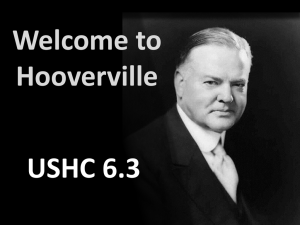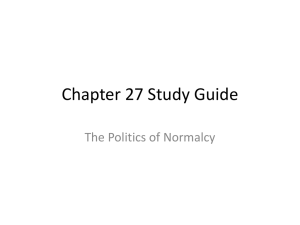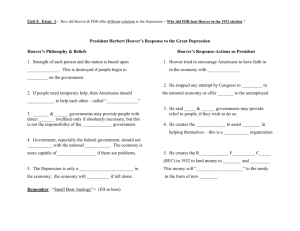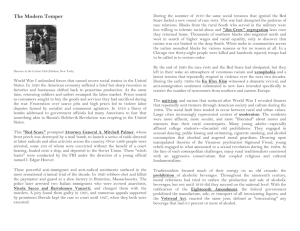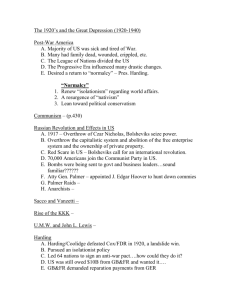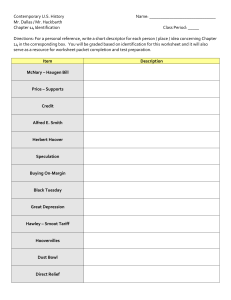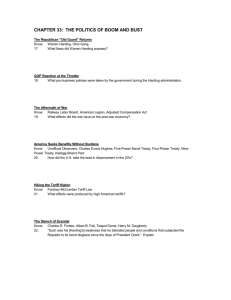Chapter Thirty
advertisement
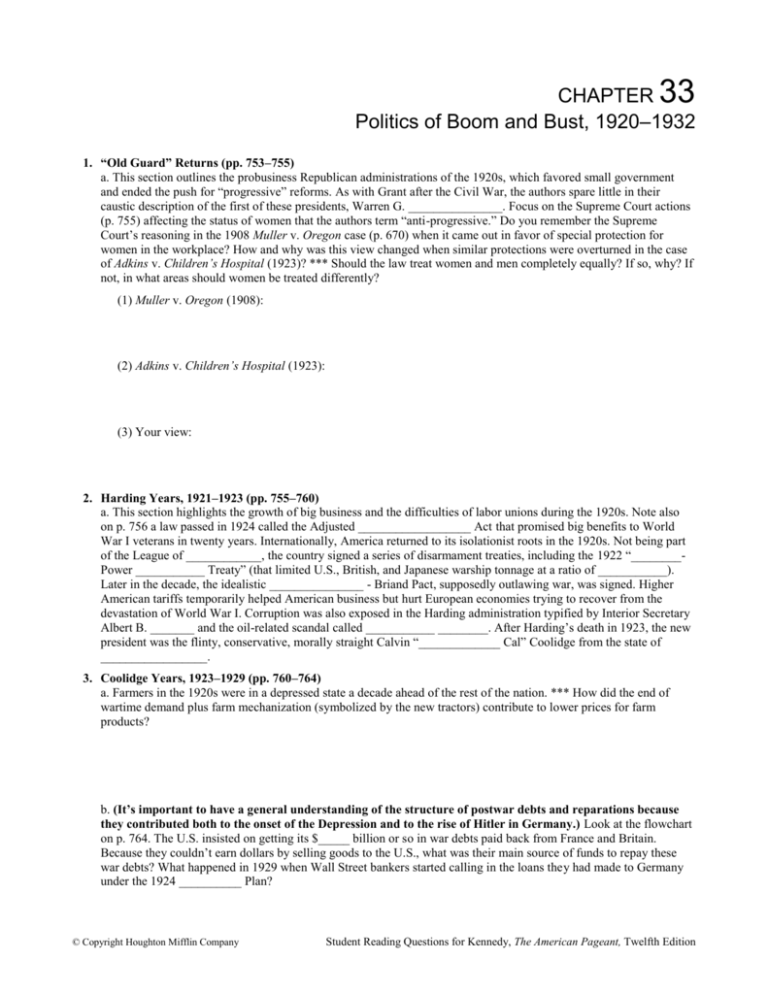
33 CHAPTER Politics of Boom and Bust, 1920–1932 1. “Old Guard” Returns (pp. 753–755) a. This section outlines the probusiness Republican administrations of the 1920s, which favored small government and ended the push for “progressive” reforms. As with Grant after the Civil War, the authors spare little in their caustic description of the first of these presidents, Warren G. _______________. Focus on the Supreme Court actions (p. 755) affecting the status of women that the authors term “anti-progressive.” Do you remember the Supreme Court’s reasoning in the 1908 Muller v. Oregon case (p. 670) when it came out in favor of special protection for women in the workplace? How and why was this view changed when similar protections were overturned in the case of Adkins v. Children’s Hospital (1923)? *** Should the law treat women and men completely equally? If so, why? If not, in what areas should women be treated differently? (1) Muller v. Oregon (1908): (2) Adkins v. Children’s Hospital (1923): (3) Your view: 2. Harding Years, 1921–1923 (pp. 755–760) a. This section highlights the growth of big business and the difficulties of labor unions during the 1920s. Note also on p. 756 a law passed in 1924 called the Adjusted __________________ Act that promised big benefits to World War I veterans in twenty years. Internationally, America returned to its isolationist roots in the 1920s. Not being part of the League of ____________, the country signed a series of disarmament treaties, including the 1922 “________Power ___________ Treaty” (that limited U.S., British, and Japanese warship tonnage at a ratio of ___________). Later in the decade, the idealistic _______________ - Briand Pact, supposedly outlawing war, was signed. Higher American tariffs temporarily helped American business but hurt European economies trying to recover from the devastation of World War I. Corruption was also exposed in the Harding administration typified by Interior Secretary Albert B. _______ and the oil-related scandal called ___________ ________. After Harding’s death in 1923, the new president was the flinty, conservative, morally straight Calvin “_____________ Cal” Coolidge from the state of _________________. 3. Coolidge Years, 1923–1929 (pp. 760–764) a. Farmers in the 1920s were in a depressed state a decade ahead of the rest of the nation. *** How did the end of wartime demand plus farm mechanization (symbolized by the new tractors) contribute to lower prices for farm products? b. (It’s important to have a general understanding of the structure of postwar debts and reparations because they contributed both to the onset of the Depression and to the rise of Hitler in Germany.) Look at the flowchart on p. 764. The U.S. insisted on getting its $_____ billion or so in war debts paid back from France and Britain. Because they couldn’t earn dollars by selling goods to the U.S., what was their main source of funds to repay these war debts? What happened in 1929 when Wall Street bankers started calling in the loans they had made to Germany under the 1924 __________ Plan? © Copyright Houghton Mifflin Company Student Reading Questions for Kennedy, The American Pageant, Twelfth Edition 4. Hoover Years, 1929–1933 (pp. 764–767) a. In the 1928 election, Republican Herbert Hoover defeated the first Catholic presidential nominee, Democrat Al __________ of New ________. The authors use words like industry, thrift, self-reliance, dignity, integrity, and humanitarian but also stiff and thin-skinned to describe the apparently well-qualified Hoover, a self-made millionaire. With the 1929 Agricultural ___________________ Act, Hoover moved modestly to help farm cooperatives help themselves, but soon afterwards, Congress passed the ___________- Smoot Tariff bill which raised average import duties to _____percent. *** Why do the authors say on p. 767 that this move played “directly into the hands of a hatefilled German demagogue, Adolf Hitler”? 5. Crash and Depression (pp. 767–770) a. The chart on p. 768 shows that the value of common stocks declined by ____percent between its high when the market crashed on “Black __________” in October 19____ and its low in 1932. A stock market “crash” is caused when everyone wants to ________ (buy or sell) and no one wants to _______ (buy or sell) their ownership of shares in companies. *** What do you think might cause people suddenly to dump their shares on the market? b. The authors provide a number of graphic examples of how the “foundations of America’s social and political structure” were severely and almost fatally shaken by the decade-long Great Depression, which descended starting in 1930. The stock market crash, by reducing the savings of investors and creating a negative psychological mood, was only one small factor in the onset of this Depression. Summarize these three main causes of the Depression cited by the authors. (1) Overproduction and income disparities: (2) Overexpansion of credit: (3) Economic problems abroad: 6. Hoover and the Depression (pp. 770–773) a. Hoover was a humanitarian, but as a conservative he felt government handouts to the poor would destroy the “national fiber.” When Hoover did substantially alter his principles by spending large sums of government money, it was for public works such as the ___________ Dam and for the _______________ Finance Corporation (RFC). Who received funds from the RFC and how did this illustrate the conservative Hoover’s belief that the benefits of such programs would eventually “trickle down” to the masses? © Copyright Houghton Mifflin Company Student Reading Questions for Kennedy, The American Pageant, Twelfth Edition 7. Bonus Army and Foreign Events (pp. 774–776) The final blow to Hoover’s reputation occurred in 19____ when he ordered General Douglas _______________ to evict the remaining elements of the __________ Army, a large group of World War I veterans who came to Washington to demand early payment of war bonuses. Overseas, Japan was expanding without restraint by the League of Nations. *** What do the authors mean (pp. 774–775) when they conclude that “collective security died and World War II was born in 1931 on the windswept plains of Manchuria”? © Copyright Houghton Mifflin Company Student Reading Questions for Kennedy, The American Pageant, Twelfth Edition CHAPTER 33 TERM SHEET Politics of Boom and Bust, 1920–1932 Pages 753–755 Warren G. Harding Charles Evans Hughes Andrew W. Mellon Herbert Hoover Sen. Albert B. Fall Harry M. Daugherty “laissez-faire” economics William Howard Taft Adkins v. Children’s Hospital (1923) Pages 755–756 Esch-Cummins Transportation Act (1920) Merchant Marine Act (1920) Veterans Bureau (1921) Adjusted Compensation Act (Bonus Bill) 1924 Washington “Disarmament” Conference (1921–1922) Five Power Naval Treaty (1922) / 5-5-3 ratio Kellogg-Briand Pact (1928) Fordney-McCumber Tariff (1922) Teapot Dome Scandal (1923) Death of Harding (1923) Calvin Coolidge Pages 760–764 1920s farm depression Capper-Volstead Act (1921) McNary-Haugen Bill/Coolidge veto John W. Davis © Copyright Houghton Mifflin Company Student Reading Questions for Kennedy, The American Pageant, Twelfth Edition Robert M. La Follette Allied war debts German reparations Dawes Plan (1924) Pages 764–767 Alfred E. Smith/1928 election Agricultural Marketing Act (1929) Federal Farm Board Hawley-Smoot Tariff (1930) Pages 767–770 Speculative bubble “Black Tuesday” (October 29, 1929) Great Depression “Hoovervilles” Pages 770–773 “Trickle down” economic theory “Public works” projects Reconstruction Finance Corporation (RFC) (1932) Norris-LaGuardia Act (1932) “Yellow dog” contracts Pages 774–776 Bonus Army (1932) Gen. Douglas MacArthur Manchuria (1931) Henry L. Stimson “Collective security” “Good Neighbor” policy © Copyright Houghton Mifflin Company Student Reading Questions for Kennedy, The American Pageant, Twelfth Edition
